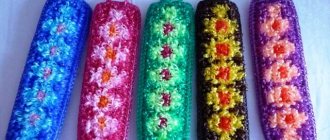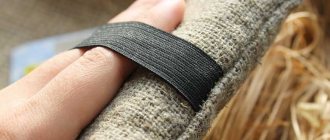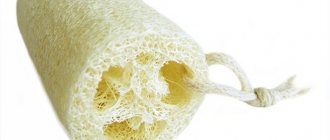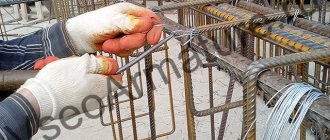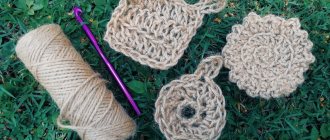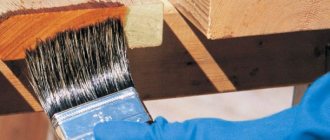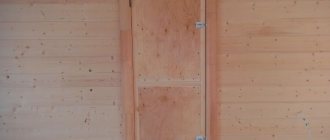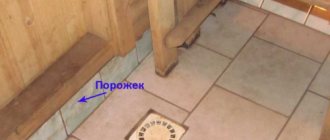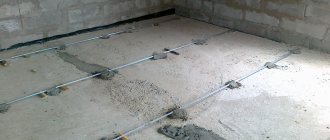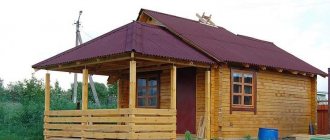A good washcloth is an essential attribute of a bath. It is suitable not only for delicate and high-quality cleansing of the skin, but also for massage. However, in order for the product to bring you maximum benefit, it is important to know exactly which washcloth is right for you.
So, let's talk about the main types of washcloths and look at the main criteria for their selection.
5/5 — (1 vote)
Don't forget that each family member should have their own washcloth. Products intended for adults may not be suitable for children due to their roughness. It is best to get a pair of washcloths with different characteristics and purposes.
How to decide on knitting needles
The selection of knitting needles for knitting a washcloth will depend on several factors.
First, you must decide on the shape of the future product. For example, if you want to knit an object in the form of a pipe, with handles attached to the ends (this model is convenient for massaging your back), then you need stocking needles. This is a special set consisting of five short knitting needles of different thicknesses, which are not equipped with tips and are not connected by fishing line. With their help, you can knit the product in the round, which will save you from the need to sew it. If you plan to create a shaped washcloth - round, square, or in the form of a bath mitten - then you will only need two knitting needles. But in this case, you have to knit 2 identical halves of the washcloth, which then need to be sewn. Beginners may find it difficult to use double needles to create a seamless project, so they may opt for two needles.
As for the size of the knitting needles, it all depends on what density of the sponge you want to get at the end. If you like a dense product, then the threads and knitting needles should be thinner. There is a desire to make a soft washcloth with a loose texture - then knitting needles, the size of which starts from number seven, will come in handy. You also need a pair of thin knitting needles with which you will knit handles for the washcloth if you plan to make them. If you have the skill, you can use a crochet hook instead of knitting needles to create handles.
Another material that may be needed for the product is foam rubber. It is needed if you want a homemade knitted washcloth to absorb water well and be soft. Foam rubber can be purchased at fabric stores and craft departments. It is sold in sticks and in the form of a filler consisting of chopped small squares.
Question answer
What is the best washcloth to use for washing a small child over the age of one year?
It is best to use soft sponges or “roses” made of nylon fibers. Such products provide good foam and do not scratch the baby’s delicate skin.
If traces of mold appear on a washcloth, what can be done in this situation and why did this happen?
Mold usually forms on natural washcloths that are not dried after use. It is no longer safe to crumple such a product. It is best to immediately discard the washcloth and buy a new one.
How to properly store a washcloth after use?
You can store a washcloth in a bathhouse, dressing room or at home. The most important thing is that the product must be suspended so that water can drain from it. If possible, it is best to dry the washcloth immediately after use in a well-ventilated area.
Which washcloth should you use if you have a lot of pimples and acne on your body?
In this case, it is best to completely abandon the washcloth for a while. In extreme cases, you can use a soft and gentle sponge.
Is it possible to wash a washcloth in a washing machine with other things?
Yes, you can. However, you should select the appropriate washing mode. This is one of the most effective ways to care for your product.
Popular knitting patterns
The most popular option for handmade washcloths knitted on knitting needles today are shaggy ones. They look very fluffy. In addition, it is with this knitting technique that you can make bath accessories in the form of animals or toys. Such products, as a rule, are made to please children. To create them, you need to master the technique of knitting elongated loops. This method is also called “fur knitting”.
First, cast on the required number of loops (their number depends on the width of the washcloth you want to knit). Knit the first row completely with knit stitches, and the second row with purl stitches. Repeat the knit and purl row one more time. Then, at the beginning of a new row, knit one loop, then form a loop with your finger from the free thread and pull it out before knitting. This loop should be one and a half to two centimeters long and located between the two knit stitches, as shown in the diagram. Knit the next stitch and pull out a long loop again. Complete the entire row this way.
Purl the reverse side completely to secure the long stitches. Make the next front row again with elongated loops and knit in this way to the length to which you want your washcloth to be. In the finale, knit a couple of rows again in plain satin stitch. You can knit ropes for the handle using a crochet hook. Alternatively, cast on three stitches and work with the satin stitch facing up to the length you want the arm to be. Fold it in half and sew it to the washcloth. If desired, you can push foam rubber inside the product.
It is much easier to knit washcloths, the patterns of which simply alternate purl and knit rows or loops. The simplest method is garter stitch. The instructions for doing it are simple: just cast on the required number of stitches on the knitting needles and knit each row with knit stitches (both knit rows and purl rows). As a result, you will get a ribbed cloth that will clean the skin well as a washcloth.
The next knitting technique, based on alternating knit and purl stitches, is called “tangle” or “pearl knitting”. In this case, you need to knit one knit stitch in the first row, then purl it, knit it again, purl it until the end of the row. On the reverse side, knit the knit stitch in place, and vice versa. The result should be a three-dimensional pattern, as if studded with beads. A washcloth tied in this way can be used for anti-cellulite massage while going to the bathhouse.
A “checkerboard” pattern is knitted using a method similar to the previous one. Only in this case, not single loops alternate, but two or more. A 3x3, 4x4 or 5 by 5 pattern looks good.
For example, you knit three stitches, then purl three. On the reverse side you need to knit according to the pattern. In this way, you need to knit three rows so that you get even squares. In the fourth row, in place of three knit ones, you need to knit three purl ones, then three left ones - so that the squares are arranged in a checkerboard pattern.
Where can I buy
You can buy a washcloth both in online stores and offline supermarkets or small outlets with cosmetics and household chemicals. The advantage of “live” stores is that you can touch the product and tactilely evaluate its hardness. But when buying online, you save a lot of time.
It is also easier to find washcloths made from unusual, rare materials via the Internet - on social networks, on thematic websites, and message boards. What should you pay attention to in this case? Look at the seller’s reputation, its rating, read reviews. Pay attention to how long the seller or business has been in business. Don't trust fly-by-nighters. Study product photos.
How to knit a washcloth? Basic moments
The process of knitting a washcloth includes a number of stages:
- The choice of material for the washcloth.
- Selection of knitting tools.
- Choosing the shape of the washcloth.
- Directly knitting a washcloth.
Let's look at these steps in more detail.
Which tool to choose for knitting a washcloth
Knitting washcloths can be crocheted or knitted. Both options make it possible to realize any idea and knit a washcloth of any size and shape.
The choice is based on personal preferences and skills, if you know how to crochet, then knit with it, if knitting needles are closer to you, then choose this method of knitting. As a rule, the product is knitted faster, but most people use a crochet hook.
If you have never knitted before, it is preferable to start with a hook; it is easier to work with than with knitting needles.
Washcloths for a bath should be knitted loosely, without pulling the thread too tightly. This is necessary to make the washcloth flexible and soft. If you want the washcloth to foam better and be even softer, you can insert a piece of foam rubber into it.
What material to choose for knitting washcloths
Today you can see in stores washcloths made of different materials, differing in hardness, durability and other properties. The most common option is hand-knitted polypropylene washcloths. These are what grandmothers sell at the market.
Polypropylene is a cheap, wear-resistant material that perfectly retains its shape and has good rigidity, which makes it possible to efficiently remove the stratum corneum of the skin. Polypropylene thread can be easily found in any craft store; the color range of such yarn is huge.
The disadvantage of polypropylene is that it is artificial, therefore it can cause allergies and is not suitable for people with sensitive skin.
Do you prefer washcloths made from natural materials? Pay attention to the bast - fibers extracted from the inside of the linden tree. This material makes durable and environmentally friendly washcloths.
They cleanse the skin well and have a beneficial effect on the body thanks to the phytoncides released when the fibers are heated. A well-known and popular material for washcloths is loofah. For its production, fruits of the pumpkin family are used. Loofah is tough and can be used to effectively scrub the body, removing all dead cells. Loofah washcloths are especially popular among women, as they are good helpers in the fight against cellulite.
Sisal, a material made from the fibers of tropical plant leaves, will help get rid of orange peel and effectively cleanse the skin of impurities and dead skin layers.
If we return to the origins and traditions of the Russian bath, we suggest paying attention to flax. This material is perfect for washcloths; it has high strength, long service life, environmentally friendly composition, a pleasant aroma and has a healing effect on the body.
Want a little exotic? Pay attention to the ramie washcloth - Chinese nettle. It has medium hardness, so it is suitable for all skin types.
Thanks to the substances contained in the fibers, the washcloth has an anti-inflammatory and rejuvenating effect.
But not each of the above materials is suitable for knitting washcloths for a bath with your own hands. As already mentioned, the simplest and cheapest option is polypropylene threads for washcloths. You can also use sheep or goat wool, silk threads for sensitive skin, nylon threads, cotton or linen yarn.
Which yarn won't work?
Mohair, angora - all “fluffy” threads. To knit a washcloth, it is better to take non-fluffy yarn that will not deform if it comes into frequent contact with water.
How to knit elongated loops
If you have never knitted with elongated loops, then you should first try to knit a sample from simple threads in order to practice and work out the tightness of the knitting. The fact is that you need to knit tightly with long loops, i.e. Tighten each loop with columns so that the fabric is not loose. It will be especially difficult for beginners to immediately knit elongated loops from polypropylene threads.
Foam sponges
Delicate and soft, giving abundant foam. Of course, they cannot thoroughly wash the body due to their structure, but there are also combined options.
Flaws:
- They turn sour quickly (if you don’t dry them in time).
- They quickly lose their presentation (tear).
- Too bright foam “bunnies” and “fruits” can cause allergies.
A little history and purpose
It is not known for certain when the first devices appeared to help cleanse the skin, but already in references in Babylon and Ancient Greece there is information about the first washcloths. Wealthy people used wood or bronze to wash their skin, while poor people used bunches of plants or sand.
Now, a washcloth is already an absolutely necessary household item for every person. Beautifully designed, of different sizes, colors and purposes, they decorate the bathroom and are indispensable assistants in the bathroom.
A washcloth can be made from any available material: natural cotton or chintz, using old terry towels, woven from burlap, and for those who are not looking for easy ways - knitted.
Made from sisal
Many people have heard about the fiber obtained from agave leaves. As a rule, such washcloths are cute woven mittens.
Among the advantages are:
- Pronounced anti-cellulite effect.
- Peeling properties and acceleration of blood circulation.
- Long service life.
There are many more disadvantages:
- Increased rigidity (too rough washcloth). It is not recommended to use it more than twice a week. And for people with an abundance of moles and sensitive skin, it is better to abandon it altogether in favor of a softer washcloth.
- Low foaming.
- Requires soaking in hot water.
- High price.
Round washcloth
Another simple option is a round washcloth, which looks original. If you knit with colored stripes, you will get a flower-like accessory. In this case, it is better to choose a simple pattern, for example, garter stitch.
Cast on 20 stitches and perform a row of knit stitches. In every second row, knit the first two loops together, and before knitting the last one, yarn over. So the number of loops will be the same in each row, but the fabric will be slightly beveled. The length of the product should be 2-3 times greater than the width to create a voluminous accessory.
Close the loops. Fold the resulting rectangle in half, combine the first and last rows and sew them. It turns out to be a pipe. Thread a thread through the edge of the top row, pull the ends together, and tie a knot. Repeat the same with the bottom edge. Align the centers and secure. The result is a round, voluminous ball, flattened at both ends.
Knitting a washcloth is a fun activity that is easy to learn. These homemade bath accessories are a good gift for children and adults.
Rating of quality washcloths for body care for the year
We offer you an overview of the highest quality and most popular models with comprehensive descriptions, pros and cons. The list includes products for every taste and budget - there are options here, both synthetic and natural, hard and soft, expensive and budget.
Kelebek Kese soft mitten
Smooth massage sponge made of knitted yarn
This smooth sponge is knitted from strips of fabric that can be made in a variety of ways. But first, let's choose a suitable fabric that won't fray at the edges when cut. When it comes to knitting, it is best to use synthetic pieces of old clothing or tights. It is necessary to choose the largest piece of fabric so that when cutting you get a long ribbon without knots.
There are many ways to cut any piece of knitwear. The first technique involves moving the scissors in a spiral. Cutting a piece from one corner, we move to the nearest corner. In the second corner we turn the scissors and cut at an angle of 90 degrees. So we move, cutting the piece from the edge to the middle. In this case, you need to cut off the corners and ensure that the strips are of equal thickness:
You can cut the fabric into serpentine strips. At the same time, we start cutting from any corner and move to the opposite corner. Not reaching the second edge by a couple of centimeters, turn the scissors 180 degrees and cut in the opposite direction. Using this technique, we cut the fabric to the very end, and you also need to round the corners. We wrap the finished elements into a ball and begin to perform them with a set of 11 P.
Let's make 8 P with a garter stitch pattern.
If you have stripes of different colors, then continue making 10 R with the second shade. Next, go back to the first fabric color.
We alternate the shades of fabric yarn to get this color. Then close the P of the last row and sew three strips to the ends.
We braid a braid from these strips, and make the same braid on the other side of the washcloth.
How to crochet a flat washcloth: a lesson for beginners
A flat washcloth is a traditional type of bath accessory. This sponge is practical and easy to knit, so even a beginner can do the job. The simplest crochet patterns and patterns are used for the work. Typically, flat washcloths are made either oval or round. If it is an oval, then a handle from st. b/n or air loops. Flat washcloths st. b/n in a circle. You can first divide the product into sections and first knit the chain of the initial row in the center, and then make a square or rectangle, as shown in the diagram.
When performing a circular washcloth, the initial ring is formed first. Then, using lifting loops, uniform increases are made. Basic pattern st. b/n. To make the washcloth comfortable to hold in your hand, you can sew a rectangular strap to the reverse side that fits on your hand. You can knit 2 identical circles and then sew them, but not all the way, to place the soap inside. Also, instead of a strap, you can use a lace made of air stitches and stitches. b/n. A great idea would be to create a round washcloth from elongated loops.
Sand, ash, iron scrapers and other ways to clean up
Once upon a time, our ancestors cleaned the body with simple sand or ash, scraping the skin with special blades made of bronze (for the rich) or wood. To effectively cleanse the body of dirt, sweat and sebum, birch brooms, bast, hemp and other available materials were used. Everything changed in the 30s of the twentieth century with the invention of foam rubber. Foam sponges quickly became the most affordable and popular washing accessory, and thanks to their bright colors and various shapes, they were loved even by children. They were replaced by a real boom in nylon washcloths. Lightweight, durable, bright and affordable synthetic washcloths have occupied the podium for a long time.
But the 21st century is making its own adjustments: everything natural and environmentally friendly is coming into fashion, including washcloths. Bast, linen and even birch bark washing accessories and natural sponges are returning to the shelves. Which body washcloths are best?
How to knit a round washcloth: a master class for beginners
Round ball-shaped sponges are practical sponges to use. They foam well, retain moisture, and are at the same time convenient to use. Making such a sponge is very simple. First, you need to dial on 10 chain stitches and connect them into a ring. Then, do s/s in the 1st point of the chain. Then, according to the scheme:
- 1st R.: Art. b/n in the ring (5 v. p., 1 tbsp. b/n) – repeat 40 r. Then, 30th century. p., art. b/n remove, s/s 1st art. b/n;
- 2nd row: s/s in the 1st arch from the 5th century. p., 4th century n., n. 1st century p., - 7 times in the same arch. Further, in each arch 5 c. p. Repeat 8 p. S/s in each point of the arch from the 30th century. p. S/s from the 3rd century. st from the initial 4 sts of lifting;
- 3rd row: Art. b/n in the 1st arch from the 1st century. p. (2 v. p., treble b/n following the arch of 1 v. p.) – 320 times. S/s from 1st Art. b/n.
You will get a lush, spherical sponge. Knit another chain of chain stitches to make a loop for the hanger. Cool sponge is ready!
Sea sponges
Very soft, delicate and pleasant to the body - with a porous soft structure. They foam well and do not cause skin irritation or allergies.
They can be easily used on baby skin or to cleanse delicate facial skin.
But there are also disadvantages:
- Very short life span.
- Very high cost.
- Hardens after drying.
- Requires replacement every 2-3 months.
Of course, these are not all washcloths. There are also examples for hamam, eco-scrubbers made of cellulose, and so on. The variety is great, and the choice is limited only by wishes and wallet size.
We crochet a washcloth for children: mittens and washcloths with elongated loops
The mitten is an original, comfortable and fun idea that will turn any bathing experience into an exciting game. A child will especially like this sponge. You can embody the most original ideas and turn a mitten into a teddy bear, piglet, frog and other animals. According to the mitten pattern, you can crochet absolutely any washcloth using a regular crochet stitch. b/n or elongated loops.
If you don’t know what kind of sponge to crochet, we offer a selection of interesting ideas for beginners to add to your collection. Your baby will be delighted to swim with a colorful caterpillar, hedgehog or owl:
We crochet a washcloth with elongated loops: video master class
Many beginning knitters are faced with the question of how to crochet a washcloth with elongated loops. This is a very original and interesting technique with which you can make a practical sponge instead of store-bought ones. Knitting is very simple, so even a beginner can master the technique. Look for more original ideas on the website, and follow new products and current trends in the world of knitting with us! How to crochet a washcloth with elongated loops, master class with detailed description for beginners:
The best manufacturers
The best brand is the one that produces reliable, safe and beautiful products. Asking the question “Which company is better to choose?” We hope to find among the many manufacturers those who use only high-quality raw materials for their products and adhere to state production standards. In addition, their products receive a positive response from customers.
We conducted a detailed analysis of the market for cosmetic accessories manufacturers and compiled a list of the best:
- Banika (Russia);
- Beauty format (Russia);
- CAN DO(China);
- Faberlic (Russia);
- Forster's (Germany);
- Kelebek (Türkiye);
- Kokubo (Japan);
- OH:E (Japan);
- Paterra (China);
- Silva (Russia).
Ergonomic knitted washcloth
The process of creating a bath masterpiece consists of the following stages:
- loops are cast on - 32 pcs. (8 pieces for each knitting needle);
- knit 3-4 rows with knit stitches;
- a transition is made to the pattern - a row with elongated loops alternates with rows with facial loops;
- knit 3-4 rows with knit stitches - complete the work;
- handles are made - loops are gathered from the edge of the washcloth, a “rope” is knitted and fixed on the other side of the accessory (ribbons can be sewn on).
A convenient accessory is ready! And to make it exclusive, you can use multi-colored yarn.
If any difficulties arise, watch the master classes. But, as practice shows, tying a “gift” accessory correctly is not difficult!
An anecdote on the topic: A cat’s tongue is not only a tongue, but also a spoon, a mug, a toothbrush, a fur brush, soap, a washcloth and toilet paper!
Good luck to you, lovely craftswomen! And peace to your home! Bye!
Wisdom Quote: Teach and learn the best (Thales).
Before you start knitting a washcloth, you need to decide on the size and shape of the future product. In this case there are no strict restrictions. For children, you can knit a curl in the form of a fun toy. The shape of the washcloth depends on preference: you can make it round, rectangular or in the form of a pipe. You can knit a mitten or mitten. It all depends on the wishes of the craftswoman or the customer.
Loofah, also a massager, scrub and anti-cellulite product
If you don't like to wash with a washcloth and prefer to apply shower gel or soap to your body with your hands, no one will call you dirty. Wash for your health. But first, look at what useful bonuses you are depriving yourself of.
Benefits of washing with a loofah:
- Body massage
. Friction with a washcloth warms up and further relaxes the muscles, accelerates lymph flow and blood flow. With regular use of a washcloth or massage brush, the skin on the abdomen, thighs and buttocks will become noticeably tighter and firmer. - Exfoliation of dead cells
. You will definitely cleanse your body by simply washing it with soap or shower gel. However, a washcloth helps remove the upper invisible layer of dead cells: as a result, metabolic processes are stimulated, pores open, and the skin begins to breathe. - Prevention of ingrown hairs
. This point is especially relevant for women. Friction with a washcloth helps prevent such unpleasant phenomena as ingrown hairs after epilation and shaving, as well as irritation and pustules in the areas of ingrown hairs. - Economical use of detergent
. Not the most obvious point, but it’s impossible not to mention it. Using a washcloth, a small drop of shower gel turns into a cloud of thick foam that can easily be used to wash your entire body. While the same drop of gel on the palm is hardly enough for one leg.
Massage washcloth made from strips of fabric
For this washcloth, you can use strips of fabric cut from old tights or any old synthetic items. It's better if it's at least two different colors. This knitting is best done with large knitting needles, approximately No. 7.
Master Class
Cut ribbons of fabric and roll it into a ball. Cast on with knitting needles 11 stitches. and knit 8p. garter stitch.
Change the color of the threads and knit 10 rubles. shawl pattern. Then we knit 28 rubles with light yarn. We change the color twice more: 10 rubles. light, 8 rub. – dark. Close the loops by knitting 2 stitches. in 1p.
At the end of the washcloth, tie three strips of fabric and weave them into a braid 35 cm long. At the other end, make the same braid.
Kese washcloth
Its homeland is the East; from ancient times to this day it has been woven in the traditional way - crocheted. First, you need to knit a handle of 40 loops with two threads, on the third, start knitting cap stitches to the end of the chain - the first handle is ready, we make the second in the same way and fasten its end to the first.
The main part of the washcloth consists of three stitches of 16 single crochets, connected to three stitches of 16 double crochets. The washcloth is ready!
It must be thoroughly washed with water and wrung out well to avoid the appearance of various bacteria and unpleasant odors, since the material used in the base does not dry well and retains moisture for a long time.
From the bast
This bathhouse “masterpiece of naturalism” is made from the subcortical linden layer. It is generally accepted that such a washcloth is the most beneficial for the skin of all existing natural ones.
Pros:
- Deep cleansing of pores.
- Destruction of microbes (note – release of phytoncides during the washing process).
- Exfoliating pronounced effect.
- Low cost.
- Medium hardness and softening in water.
Flaws:
- Short lifespan (the washcloth begins to crumble).
Round washcloth
Another simple option is a round washcloth, which looks original. If you knit with colored stripes, you will get a flower-like accessory. In this case, it is better to choose a simple pattern, for example, garter stitch.
Cast on 20 stitches and perform a row of knit stitches. In every second row, knit the first two loops together, and before knitting the last one, yarn over. So the number of loops will be the same in each row, but the fabric will be slightly beveled. The length of the product should be 2-3 times greater than the width to create a voluminous accessory. Close the loops. Fold the resulting rectangle in half, combine the first and last rows and sew them. It turns out to be a pipe. Thread a thread through the edge of the top row, pull the ends together, and tie a knot. Repeat the same with the bottom edge. Align the centers and secure. The result is a round, voluminous ball, flattened at both ends.
Crochet a chain 15 cm long and hook it in the middle. A bright curl that looks like a flower is ready.
Knitting a washcloth is a fun activity that is easy to learn. These homemade bath accessories are a good gift for children and adults.
Technology of processing bast to obtain bast
Back in the mid-1980s, markets and hardware stores in the USSR had thick paint brushes made of wood fiber, which housewives of that time used to whitewash tree trunks and borders with lime. During communist subbotniks, they were sometimes given out as tools of production, as a result of which they were safely transferred from the national economy to the private economy.
The main technological methods can be distinguished as follows:
- Linden can produce raw materials from both mature and young trees.
- The main harvesting period falls on the period from the Annunciation to Trinity.
- The bark is removed from young trees through longitudinal cuts no more than 100 cm long, in an amount of no more than 4 per trunk. Large trees are debarked on both sides, and the bark is removed using tines - wooden wedges that are driven between the subbark and the tree trunk itself. The separated parts are removed in the form of two gutters.
- A very important part of the preparatory work is soaking. It is carried out in a shallow, up to 0.5 m reservoir with a hard, flat bottom and running water. As a result, the fibers acquire the necessary qualities, primarily plasticity, and are easily separated from the supporting substrate. The duration of the procedure is a very uncertain indicator and directly depends on the specific growing conditions and quality of the material. In practice, in most cases, it can range from 2 to 7 weeks. Soaking can be avoided if the work is carried out on very young trees whose subbark has not hardened sufficiently.
- After soaking, the fiber is removed, distributed and cleaned by combing with a primitive comb.
- Next, drying begins under a canopy with good air flow and constant monitoring of the raw materials, since, like any organic material with a sufficient level of humidity, it is susceptible to rotting.
A word from Experienced! After drying, the traditional technology involved “gilding”, that is, the bast bundles were exposed to direct sun, as a result of which the surface was covered with a rich straw-golden color. Let's face it, this finishing procedure is more typical for the production of bast shoes than washcloths, since exposure to ultraviolet radiation makes the bast harder.
Washcloths were made from ready-made raw materials using a primitive twisting method, when a layer of material approximately 80 - 100 mm thick is intercepted with a rope in two places and pulled together to maintain its shape. In this context, the more correct expression is not how to weave washcloths, but how to knit them.
You can see the manufacturing process visually and more clearly in the attached video.
Remember! The service life of such a washcloth rarely exceeds 5 - 8 procedures and it is susceptible to damage by microorganisms, which is quite natural for a natural product.
Correctly deciding how to weave a washcloth for a bath is not everything; what is important is how to use it correctly. Before use, such a product must first be steamed for 5 - 7 minutes in moderately hot water, and then rinsed thoroughly in cool water.
Photos of beautiful do-it-yourself washcloths for showers and baths
Children's washcloth
A high-quality bath accessory can be made from both artificial and natural materials. Most often, harder materials are chosen; they will slightly scratch the surface of the skin. This washcloth is designed for rubbing and gently massaging the skin.
But in principle, to make washcloths yourself, you can take different threads of quality and thickness that you have at hand. They should be selected depending on the required density and rigidity.
For very delicate women's or children's skin, you can make a washcloth using natural wool, such as sheep or goat. It is best to take unpainted natural homemade material. When using woolen products, you should not immerse them in too hot water, only warm or cool. Otherwise, the product will shrink and become rough and hard.
Figure 2 – Washcloth crocheted from regular threads
To achieve an anti-cellulite effect, you should take a harder material, which will give a better effect of massage and rubbing.
The most versatile material for making washcloths at home is polypropylene yarn, which has different thicknesses, stiffness and density. In principle, this is the same twine, but presented in reels and having less rigidity. You can try to make a washcloth from it, but it will be too rough. True, twine also varies in density.
Polypropylene options have a lot of poles:
- They do not need special care, are not afraid of high temperatures, except boiling water;
- Water entering the fiber does not remain in it, so such washcloths dry quickly enough;
- They are not a breeding ground for bacteria;
- The paint does not wash out over time, and the finished product will not fade.
Among the disadvantages, one should be highlighted - artificial origin, but this material does not cause allergies, since it is chemically neutral.
Are you taking proper care of your washcloth?
It’s unlikely that anyone pays special attention to the care of washcloths. I washed it, put it on the radiator or hung it on a hook - and it’s done. However, a couple of tips on how to care for your washcloth will help extend its life.
The first thing to remember is cleanliness. Before use, a new washcloth should be rinsed thoroughly with hot water to remove dust and industrial dirt. After washing, you should also rinse it well so that no detergent or microparticles removed from the skin remain in it. Some types of artificial washcloths can even be machine washed on a delicate cycle along with your clothes. For prevention, it is useful to treat a washcloth with antiseptic agents once a week.
Proper drying is the key to preserving not only the washcloth, but also your health. A humid, warm environment is ideal for the development of bacteria and fungi, and therefore the product should be dried in a well-ventilated area or on a balcony and should not be stored near water. You shouldn’t squeeze it too hard, twist the sponge, or put it on a radiator to dry either. This causes both natural and artificial washcloths to break down faster.
Kese washcloth
Its homeland is the East; from ancient times to this day it has been woven in the traditional way - crocheted. First, you need to knit a handle of 40 loops with two threads, on the third, start knitting cap stitches to the end of the chain - the first handle is ready, we make the second in the same way and fasten its end to the first.
Like any other handicraft, it requires not only certain skills, but also some character traits that I personally do not fully possess. As a child, I watched with a shudder as my mother’s friend, having knitted half a sweater or dress, unraveled it all, because, you see, she didn’t like the style.
Appeared in my life not so long ago. I suddenly wanted to know how to knit, at least scarves, at least for a child. The idea of crocheting a washcloth came unexpectedly. Anyone who knows the technique of crocheting basic loops can crochet a washcloth. Due to the fact that the washcloth is knitted in the round, you don’t have to count stitches or worry about the shape of the product.
From loofah
A product from a plant called "crazy cucumber".
- Perfectly and deeply cleanses the skin.
- Has massage and exfoliating properties.
- Has an anti-cellulite effect.
- Accelerates the process of cell regeneration.
- It serves for a long time and has increased strength.
Flaws:
- Rough (not suitable for sensitive skin).
- Requires softening (usually it is simply soaked in hot water 15 minutes before the bath).
Master class for beginners: how to knit a fluffy washcloth
To work you will need:
- synthetic threads, better in bright colors;
- straight sp. No. 3 (select according to the thickness of the yarn).
Description
We cast on with knitting needles 30 stitches. and knit 5p. persons satin stitch
From the 6th p.m. We begin knitting elongated loops. We remove the first loop, and knit the second one like this: we hook the sp loop, as when knitting faces. satin stitch, and place the thread on top of the stitch lying on the finger.
We wrap the sp. and finger twice with yarn and knit faces. p. We knit the next p. with a regular knit stitch. Until the end of the row, we alternate knitting elongated loops and regular ones.
The master class in the photo will help you understand the technique of knitting elongated loops more clearly.
7th row: 1p. remove, the rest - persons.;
8 rubles: like the 6th rub;
Using this pattern, we knit a washcloth of the required length.
At the end we switch to faces again. Ch. Knit 5p with this pattern.
For ropes along the edges you need to tie two strips. We cast on with knitting needles 40 sts. and knit 3p. persons satin stitch We close the loops. Sew stripes along the edges of the product.
Contraindications
Despite the apparent “harmlessness”, using a regular washcloth is fraught with a lot of dangers. The list of contraindications for use contains the following:
- Sensitive skin;
- Dermatological diseases;
- Large moles, papillomas on the body;
- Blood diseases;
- Phlebeurysm;
- Damage to the skin;
- Hypertension;
- Cardiovascular diseases;
- Oncological diseases;
- Acute inflammatory diseases;
- Pregnancy.
The rougher the product, the more carefully it needs to be used.
Crochet washcloth with elongated loops, interesting ideas from the Internet
The washcloth is crocheted No. 2; it took half a skein of thread.
This washcloth is crocheted from propylene thread in 2 folds, with crochet number 5. It is knitted equally on both sides, with a “Fringe” pattern or elongated loops.
A washcloth-mitten, just like a regular washcloth, is knitted simply: 1 row of single crochets, 1 row of elongated loops.
Another option for a washcloth with elongated loops.
Materials: – polypropylene threads of different colors; – crochet hook (select the size depending on the desired density of the washcloth - the smaller the number, the denser the product will be, and vice versa).
Author Irina Kachukova. For knitting you will need: yarn “Housewife - a needlewoman for the soul and soul” 50g, 100% polyamide, package 10x50g and a hook.
The knitting pattern is very simple:
- 3 rows of single crochets
- 3 rows of lush columns
How to knit lush columns, see the diagram below in the article.
You will need: polypropylene threads of 2 colors. hook No. 3 or No. 4, needle with a wide eye. The size of the finished washcloth is 14*21 cm.
Crocheted washcloth, crocheted with lush columns:
Your washcloth can be of absolutely any shape and color (depending on the interior of the bathroom). This washcloth is knitted easily and quickly, looks great, and massages simply amazing.
You need to start knitting a washcloth from the handle: a chain of air loops of the required length, which you tie with single crochets, make a connecting stitch with the beginning of the chain, and start knitting the washcloth itself in a circle with single crochets, adding 3 to 5 stitches in each row. In this way, knit to the width of the washcloth you need, then go to the main pattern (lush column), knit 45-50 cm and finish in the opposite direction with a handle. That's it, the washcloth is ready!
Technique for knitting a lush stitch: yarn over, insert the hook into the base loop, grab the working thread and pull out a loop of arbitrary length (repeat 3-5 times). The greater the number of broaches, the more magnificent the column will be. Yarn over and pull the working thread through all the loops on the hook in one go. Make 1 air loop to secure the fluffy column. Skip one base loop and knit another 1 puff stitch into the next one.
Product comparison table
| Model | Dimensions | Hardness degree | Foaming |
| Butterfly, viscose mitten | 20x13 cm | Small and medium | Bad |
| PROFFI PS0363 sisal | 45x10 cm | Average | good |
| Art de lis, nettle | 46x10 cm | Average | Bad |
| Eva, linen | 45x10 cm | Small | Bad |
| Fine Silk sea sponge | 1.5-2 and 3-5 inches | Small | good |
| Spivak, dry massage brush | 38x7 cm | High | good |
| "Cranky" | 20x16x1 cm | High | good |
| Arix with massage effect | 15x12x17 cm | Small | good |
| Tiande, towel | 30x100 cm | Average | good |
